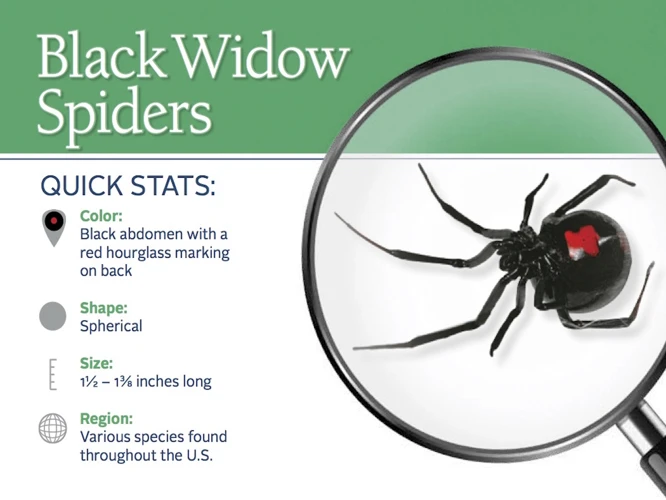As you explore the great outdoors, you may come across an intimidating creature known as the black widow spider. These fascinating arachnids have been the subject of many myths and legends, but what exactly makes them thrive in their natural habitat? In this article, we will delve into the physical features of the environment that favor the survival of black widow spiders. From climate characteristics to human interaction, we will explore the different factors that allow these spiders to prosper. So, grab your insect repellent and let’s take a closer look at the world of black widows.
Climate Characteristics
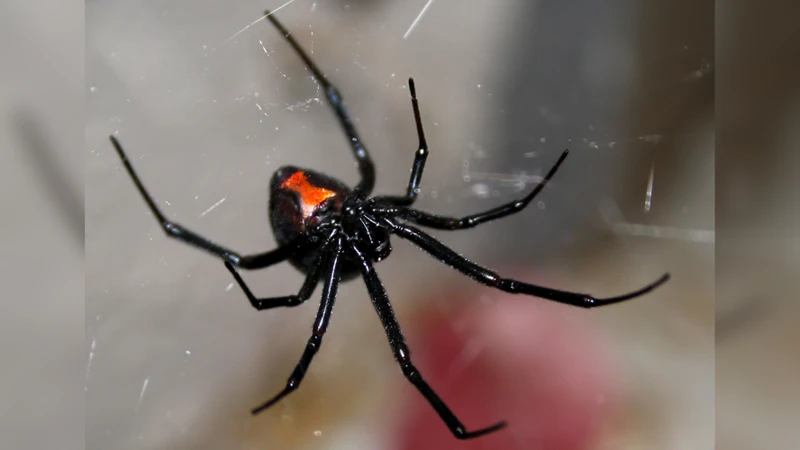
The physical features of the environment are critical in determining the survival of different species. When it comes to the black widow spider, the climate characteristics play a significant role. The black widow spider is known for its ability to adapt and flourish in various environmental conditions. In this section, we will explore the specific climate characteristics that support the survival of the black widow spider. From temperature to precipitation, we will highlight how these factors affect the distribution of black widow spiders. By the end of this section, you will have a better understanding of the environment in which black widow spiders thrive.
Temperature
Black widow spiders are accustomed to living in a warm and temperate climate. The ideal temperature range for a black widow spider’s habitat is between 70-90 degrees Fahrenheit, with a preferred temperature of around 80 degrees Fahrenheit. This temperature range allows for increased metabolic processes, which allow the spider to continue its daily activities easily.
On the other hand, temperatures below 50 degrees Fahrenheit can be quite dangerous to black widow spiders, as they can go into a dormant state similar to hibernation. This becomes especially important in areas with long and harsh winters, as black widow spider populations may not be able to survive the winter months. In regions where temperatures can drop below 40 degrees Fahrenheit, black widow spiders tend to retreat in underground chambers or protected areas to avoid the harsh weather conditions.
Interestingly, black widow spiders can also adapt to temperature fluctuations and sudden changes in the environment. The spiders are able to regulate their body temperatures through behavioral adaptations, such as moving to sunnier spots when temperatures are cooler and seeking out sheltered areas when temperatures are too high. These temperature adaptations allow black widow spider populations to survive in a variety of different environments, from the hot and arid deserts in the southwestern United States, to the more temperate and humid environments found in the southeastern United States.
To learn more about how climate affects black widow spider populations, visit /climate-black-widow-spiders/.
Humidity
Humidity plays an important role in the survival of Black Widow spiders as they prefer areas with moderate to high levels of moisture. In fact, these spiders thrive in humid environments where other arthropods struggle to survive.
Humidity Levels
Black Widow spiders prefer moisture levels ranging from 65% to 80%. These humidity levels are found in various environments, including forests, deserts, and even suburban areas. The ideal humidity level may vary depending on the specific habitat and temperature ranges.
Effects of Low Humidity
Low humidity levels may negatively impact the survival of Black Widow spiders. When moisture content drops below 40%, black widow spiders often become inactive and reduce their activities. In severe cases where humidity levels drop to 20%, dehydration may ensue and lead to death.
Effects of High Humidity
While Black Widow spiders prefer moderate to high humidity levels, extremely high moisture content may also have a negative effect. Excess moisture may cause conditions such as mildew and fungus, which can limit the availability of food and shelter for Black Widow spiders. High humidity levels may attract predators such as birds, which can reduce the population of these spiders.
| Humidity Levels | Effects on Black Widow Spiders |
|---|---|
| Below 40% | Reduced activity, dormancy |
| 65% – 80% | Ideal range for Black Widow spiders |
| Above 80% | Increase in mildew and fungus, increase in predators |
To learn about the survival of black widow spiders in urban areas, check out our article on urbanization and black widow spiders.
Precipitation
According to research, precipitation does not play a significant role in the survival of black widow spiders. They are adaptable to both dry and humid conditions. In fact, black widow spiders can be found in a variety of environments ranging from deserts to wetlands. However, moderate rainfall can stimulate the growth of vegetation, which can provide shelter and prey for black widows.
Here is a table displaying the average precipitation levels in the native areas of black widows:
| Region | Average Annual Precipitation (inches) |
|---|---|
| Southern United States | 30-60 |
| Western United States | 5-15 |
| Mexico and Central America | 20-80 |
| South America | 20-60 |
It is important to note that precipitation is just one of many factors affecting the survival of black widow spiders. For more information, visit factors affecting black widow spider distribution and black widow environments.
Geographical Locations
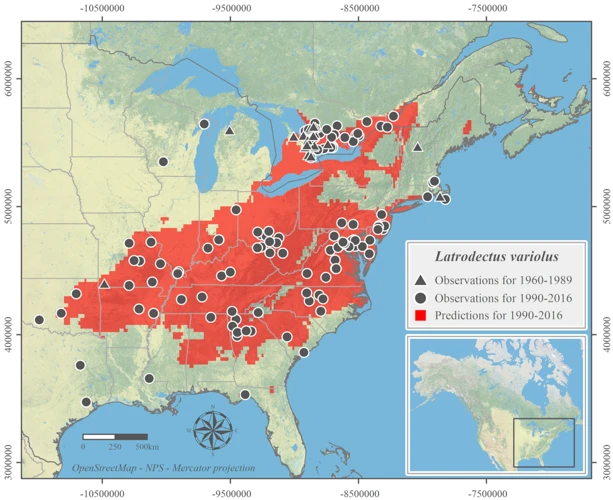
There is no denying that geographical location plays a vital role in the survival of black widow spiders. These arachnids have adapted to thriving in specific environments, and this has impacted their distribution across the globe. From their native areas to areas of introduction and migration, the geographical location has dictated their survival to a great extent. Understanding the significance of geographical locations is crucial in comprehending the behavior and ecology of black widow spiders. Let’s explore this further.
Did you know? Black widow spiders play an essential role in some ecosystems by controlling populations of other insects and pests. To learn more about the black widow role in ecosystems, click here.
Native Areas
Studies suggest that black widow spiders are native to North and South America. They are one of the most venomous spiders in the world with more than 30 recognized species. Some of the common native areas for black widows include:
- The United States: Several species of black widow spiders can be found in the United States, including the western black widow, northern black widow, southern black widow, and brown widow. These spiders are most commonly found in dry, arid regions of the country.
- Mexico & Central America: Black widows are common in the tropical regions of Mexico and Central America where they thrive in warm, humid environments.
- South America: The black widow spider is also native to South America, specifically the Andes mountain range.
Interestingly, while black widows are mostly native to the Americas, there have been reports of populations in other parts of the world where they have been introduced. These populations often result from stowaway eggs being transported in produce or other goods. As a result, black widows can be found in places far beyond their typical range.
While black widows do face threats from predators, such as birds and wasps, they have evolved to be highly resilient and adapt to a variety of environments. To learn more about the ways in which black widows survive and adapt, check out our article on Ways Black Widows Adapt.
Migration and Introduction
Introduction: Black widow spiders are native to North and South America, and they have been introduced into other parts of the world by various means, including transportation of goods, vehicles, and landscaping materials. Migration and introduction of black widow spiders to different geographical locations have contributed to their survival and propagation over time.
To better understand how black widow spiders have migrated and been introduced to different regions of the world, the following table provides detailed information:
| Region | Method of introduction | Impact on black widow survival |
|---|---|---|
| Europe | Transportation of goods | Increased survival due to abundant prey and suitable climatic conditions |
| Australia | Introduced intentionally for pest control | Thrived due to lack of natural predators and suitable habitat |
| Asia | Transportation of goods and vehicles | Survival initially limited due to unsuitable weather and habitat, but some species have adapted over time |
| Africa | Transportation of goods | Low survival rates due to unsuitable climate and habitat |
It is important to note that while the migration and introduction of black widow spiders to new regions have increased their survival, it has also sparked concerns about their impact on other species and ecosystems. In some cases, black widows can become invasive and disrupt native food webs, leading to declines in other species. Similarly, black widow spiders may not have natural predators in their new habitats, leading to unchecked population growth.
To learn more about predators of black widow spiders and common nesting sites for these spiders, please refer to our articles on predators and nesting sites.
Landscapes and Habitats
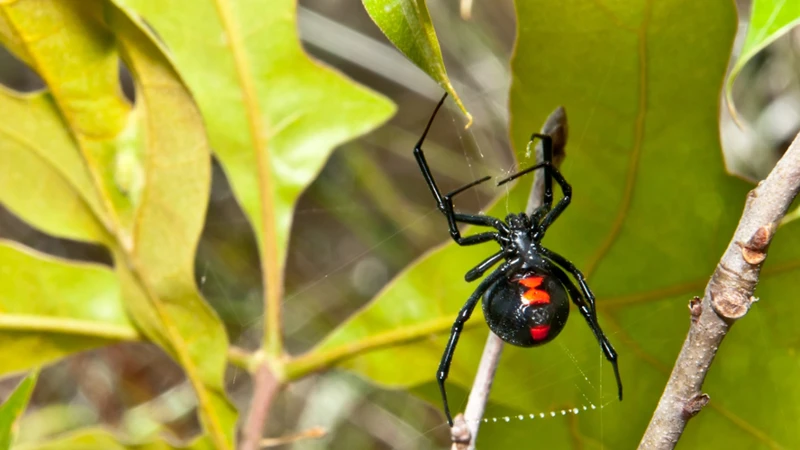
As we continue to explore the area and conditions that favor the survival of black widow spiders, it is important to consider their preferred landscapes and habitats. Black widows thrive in a variety of environments, but there are some key features that make certain areas more appealing than others for their survival and reproduction. Let’s dive into the specific traits of the landscapes and habitats that black widow spiders favor, and how they make use of them for their existence. For more information on the types of black widow spiders found, check out our detailed article on black widow spider species.
Shelter
One of the most important factors contributing to the survival of black widow spiders in the environment is their ability to find ample shelter. Black widow spiders are commonly known for their preference for sheltered locations, which include but are not limited to undisturbed piles of debris, areas around tree stumps, and inside empty containers. They have been known to nest under rocks, boards, and in underground human-made structures such as basements and crawlspaces.
In fact, black widow spiders’ nesting habits are so extensive that they can be found nesting in every conceivable type of habitat, from dense forests to urban cityscapes. Their ability to locate and utilize available shelter is critical to their ability to survive and thrive in different environments.
| Type of Shelter | Description |
|---|---|
| Debris piles | Black widow spiders use piles of debris, such as wood, rocks, and leaves, as cover and nesting sites. These types of nesting sites can provide ideal protection and camouflage. |
| Tree stumps | Tree stumps and other forms of decaying wood provide ideal hiding places and nesting sites for black widow spiders. In such locations, they are protected from direct sunlight, a critical need for their survival. |
| Empty containers | Black widow spiders often seek out abandoned containers, such as barrels or buckets, for nesting. These enclosed spaces provide protection from wind, rain, and sunlight. |
| Underground structures | Black widow spiders are commonly found in basements, crawlspaces, and other underground structures, where they have access to food and water sources and a stable temperature and humidity level. |
Black widow spiders’ ability to locate and utilize sheltered locations has made them a resilient and adaptable species, capable of surviving in a range of environments. To learn more about their survival strategies, read our article on the survival of black widow spiders in the wild or our article on the role of black widow spiders in ecosystems.
Food Sources
Black widow spiders belong to the family of arachnids, and as such, they feed on insects and other small invertebrates. These spiders’ diet comprises mainly of beetles, grasshoppers, mosquitoes, ants, termites, and other spiders.
Black widows are very versatile when it comes to their food choices, which enables them to survive in many different environments. They hunt their prey by building webs in undisturbed areas. They build their webs in crevices, under rocks, or branches, or in plants such as vines, tall grasses, and shrubs. Once a prey mistakenly wanders into the web, the black widow quickly immobilizes and captures it.
Black widows are well adapted to consume a wide range of prey, which is necessary for their survival. They are selective feeders, which means that they prefer certain prey over others. For instance, they will usually feed on large insects, even those that are larger than they are.
However, they prefer to eat insects engulfed in webbing, which is an indication that the prey is suitable for consumption. Black widows use their web to detect prey suitable for consumption. They also secrete a sticky silk that ensnares potential windblown prey. This feature allows black widows to thrive even in areas with a scarce food supply.
Black widows’ diet is quite diverse, which allows them to thrive in many different habitats and environments. However, this does not make them any less dangerous, as their venom is still potent enough to cause severe health problems. It is prudent to take caution when in areas where black widows are prevalent.
Vegetation and Terrain
Black widow spiders are often found in areas with specific vegetation and terrain, which provide them with favorable conditions for survival. Some of the vegetation that favors the presence of black widow spiders includes succulent plants, cacti, and agave. These plants thrive in dry and arid environments, which are suitable habitats for black widow spiders.
In addition to vegetation, certain terrains can also provide favorable conditions for black widow spiders to survive. These include rocky terrain and desert habitats. Black widow spiders are able to take refuge in crevices and cracks in rocks and stones, which provide shelter and a suitable environment for them to thrive.
Black widow spiders can also be found in human-made structures, including sheds, garages, and storage units. These provide suitable habitats for spiders to nest and lay their eggs, which can lead to larger populations in these areas.
It is important to note that while black widow spiders can inhabit these areas, they are not limited to them. Black widow spiders have been found in various habitats, including forests, fields, and wetlands. They adapt to their surroundings and can thrive in different environments as long as they can find shelter and food.
Human Interaction
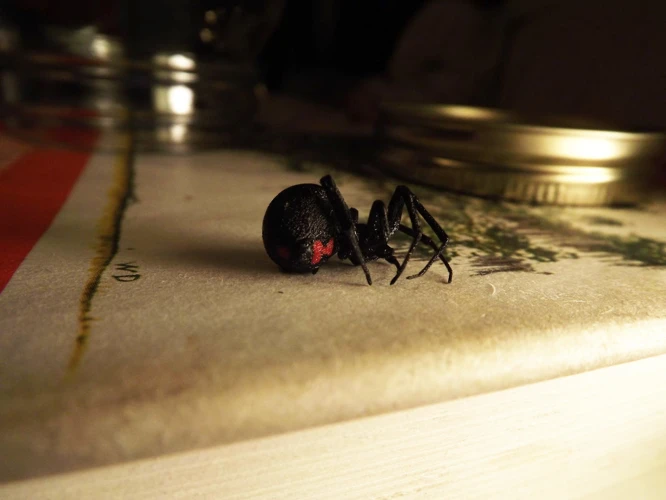
As black widow spiders thrive in many different environments, their interaction with humans is almost inevitable. While these spiders may not intentionally seek out human contact, their presence can cause alarm and concern among people. When it comes to human interaction with black widow spiders, it’s important to understand both the impact of urbanization on their habitat as well as the measures taken to control spider populations. Let’s explore how the presence of humans can affect the survival of black widow spiders.
Urbanization
As urbanization continues to rapidly expand, black widow spiders have found themselves adapting to this changing environment. This is in part due to the availability of prey and resources in human settlements. Black widow spiders thrive in areas with abundant food sources, and human settlements provide an ample availability of insects for the spiders to feed on. However, this human-spider interaction can lead to dangerous encounters for humans as black widow spiders can find their way into homes and other buildings in search for food and shelter.
Table: Urbanization and Black Widow Spiders
| Urbanization Impact | Effect on Black Widow Spiders |
|---|---|
| Increased population density | More opportunities for food and shelter |
| Highrise buildings | Can lead to increased spider encounters with humans |
| Pesticide use | Can decrease spider populations, but can also lead to pesticide resistance |
| Poor sanitation | Can create environments that favor insect presence and thus spider populations |
It is important for urban residents to take precautions against black widow spider encounters, including sealing cracks and openings in homes, wearing gloves when working outside, and using caution when handling outdoor objects. Additionally, using natural pest control methods can help decrease the need for heavy pesticide use, which can lead to environmental and health concerns. The impact of urbanization on black widow spiders is complex, with both positive and negative effects. By understanding the dynamics of this interaction, we can work towards promoting coexistence and reducing the risk of spider encounters for humans.
Pest Control
Controlling the population of black widow spiders is essential for minimizing the risk of bites and their potential negative effects. Here are some of the pest control measures that can be taken:
- Sanitation: Keeping the environment clean is a fundamental step in controlling black widow spiders. Removing debris, clutter, and any potential hiding spaces will discourage these spiders from settling in the area.
- Chemical Control: Using pesticides to target black widow spiders can be an effective control measure. However, it’s crucial to use caution when handling and applying these chemicals, as they can be hazardous to human health and the environment. Consulting with a professional pest control service is recommended to ensure proper and safe application.
- Physical Traps: Placing sticky traps or glueboards strategically around the environment can help capture and control black widow spiders.
- Natural Predators: Introducing natural predators, such as other spider species or insects that prey on black widow spiders, can be an effective biological control measure. However, this method requires careful consideration of the potential impact on the ecosystem.
It’s worth noting that prevention is key. Taking the necessary actions to deter black widow spiders from settling in the environment in the first place can significantly reduce the need for pest control measures.
Dangers and Prevention
One of the most important aspects of dealing with black widow spiders is understanding the potential dangers they pose. While these spiders have fascinating characteristics, they are also quite dangerous and can cause serious harm to humans. It is essential to know how to prevent and address issues related to black widow spiders in order to mitigate any potential risks. In this section, we will discuss the various dangers associated with black widow spiders and the best ways to prevent and deal with them.
Bites and Symptoms
When it comes to bites from black widow spiders, it is important to understand the symptoms and the potential dangers they can cause. Here are the key points to keep in mind:
- Bite appearance: The bite from a black widow spider typically appears as two small puncture wounds, which may be red and swollen.
- Initial symptoms: Within the first hour or two of being bitten, you may experience symptoms such as muscle pain and cramps, nausea, sweating, and difficulty breathing.
- Severe symptoms: In some cases, black widow spider bites can cause more severe symptoms such as chest and abdominal pain, high blood pressure, and seizures. If you experience these symptoms, seek medical attention immediately as they can be life-threatening.
- Risk groups: Certain groups of people may be at higher risk of developing severe reactions to black widow spider bites, including young children, elderly people, and those with weakened immune systems.
- Prevention: To reduce the risk of being bitten by a black widow spider, take precautions such as wearing gloves and long sleeves when working outdoors, shaking out clothing and shoes before putting them on, and keeping your home clean and free of clutter.
- Treatment: If you do get bitten by a black widow spider, seek medical attention immediately. Treatment may include pain-relieving medications, muscle relaxants, and in severe cases, antivenom.
It’s important to remember that while black widow spiders can be dangerous, bites are rare and can often be prevented with simple precautions. If you do experience symptoms of a black widow spider bite, seek medical attention immediately to ensure prompt and effective treatment.
Control Measures
One of the most important aspects of controlling and preventing black widow spider infestations is through effective measures. Here are some control measures that can be taken to curb the presence of black widow spiders in specific areas:
- Sanitation: Keep your environment clean by eliminating clutter, debris, and food sources. This will reduce hiding places for black widow spiders and their prey.
- Exclusion: Prevent the entry of spiders into buildings, homes, and other areas by sealing cracks, gaps, and openings in doors, windows, and foundations.
- Chemical Control: If the problem persists, it may be necessary to use chemical control measures such as pesticides, aerosols or dusts. It is important to follow established guidelines for use and application and to hire a professional to assist with this step.
- Visual Inspection: Conduct regular inspections to identify, and eliminate infestations in their early stages. This can help prevent subsequent bites and serious symptoms that may result.
It is important to note that in all control measures, safety is paramount. Due to the potency of the venom, proper protective gear should be worn during any extermination process. It is critical to keep children and pets away from the areas where black widow spiders have been identified. Applying measures as described above can diminish the risk of infestations and minimize exposure to harmful venom.
Conclusion
In conclusion, it can be observed that black widow spiders have certain physical features that allow them to thrive in specific environments. These spiders are particularly adapted to live in warm and humid regions, where they can find shelter in crevices and holes in the ground or in natural formations like rocks or logs. They are also able to survive in urban environments, which often provide them with abundant food sources such as insects and other prey.
Moreover, black widow spiders have a unique venomous bite that poses a potential danger to humans and other animals. Therefore, it is important to take preventative measures to keep them at bay, such as keeping yards free of debris, sealing cracks or openings, and practicing appropriate pest control.
Overall, while black widow spiders may be a fascinating species to observe, it is important to exercise caution and respect their natural habitat. With its striking black and red appearance and potentially deadly venom, this spider certainly has a place in the ecosystem, but it is best to admire it from a safe distance.
Frequently Asked Questions
What’s the size of a black widow spider?
Female black widow spiders can grow up to 1.5 inches, while males are usually half that size
What is the black widow spider’s habitat?
Black widow spiders are usually found in dark, secluded areas such as crevices, wood piles or holes in the ground.
What do black widow spiders eat?
Black widow spiders mainly feed on small insects, including flies, mosquitoes, and caterpillars.
How do black widow spiders catch their prey?
Black widow spiders use their webs to catch their prey. Once the prey is trapped, the spider delivers a bite and wraps the prey in silk for later consumption.
Are black widow spiders dangerous to humans?
Yes, black widow spiders can be dangerous to humans. Their venom is highly toxic and can cause various symptoms, including muscle cramps, nausea, and convulsions. However, bites are seldom fatal if treated promptly.
What is the mating behavior of black widow spiders?
After mating, the female black widow spider often eats the male. However, this only happens in captivity, as the males typically escape after mating in the wild.
How can you prevent a black widow spider infestation in your home?
Keeping your home clean and free of clutter can reduce the risk of a black widow spider infestation. Seal up any cracks or holes in walls or foundation, and use insecticides to kill any spiders that get inside.
What should you do if you are bitten by a black widow spider?
If you suspect you’ve been bitten by a black widow spider, seek medical attention immediately. Treatment may include antivenom or pain management for symptoms.
What is the lifespan of a black widow spider?
The lifespan of a female black widow spider can be up to three years, while males typically only live for a few months.
Can black widow spider venom be used for medical purposes?
Yes, components of black widow spider venom can be used to treat various medical conditions, including chronic pain and certain neurological disorders.

